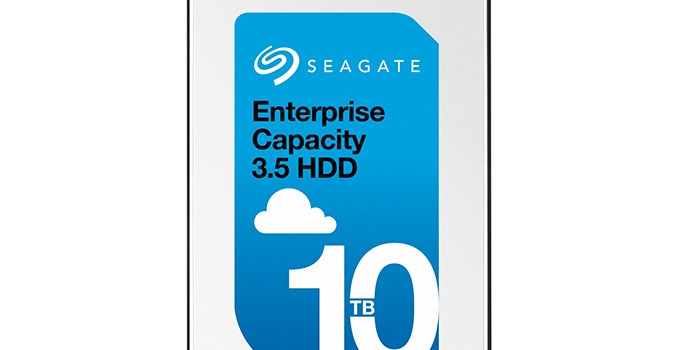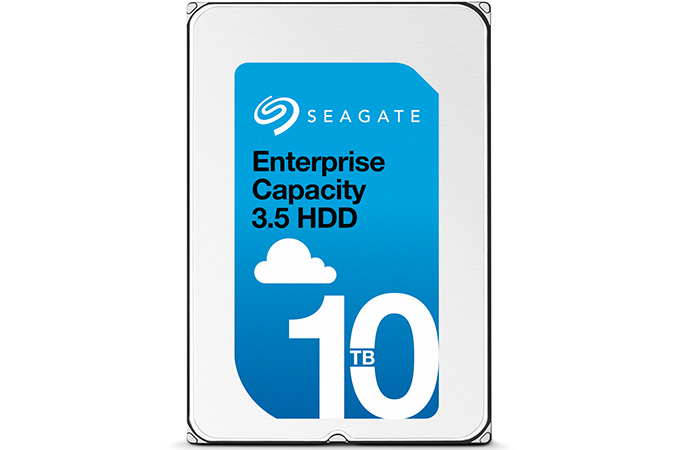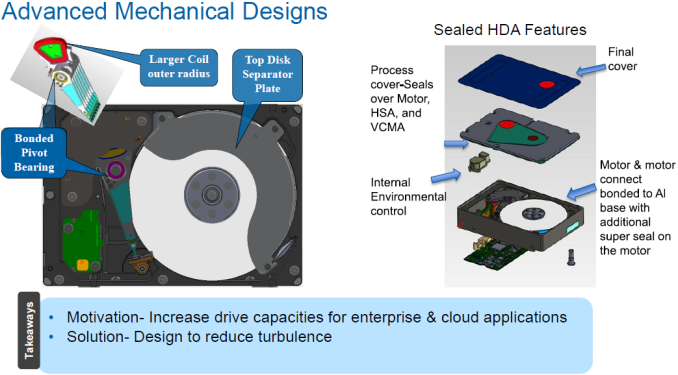Seagate Begins Volume Shipments of Helium-Filled HDDs, Reveals Their Final Specs
Seagate has started volume shipments of its first helium-filled hard drives. They were announced earlier this year. The new HDDs are available to all interested parties, which means that Seagate’s biggest customers have already evaluated and validated them. Volume shipments of the 8 TB and 10 TB helium-filled hard drives will help Seagate to improve its financial results and margins, since the new HDDs will be amongst the most expensive drives in the company’s lineup.
Brand New Platform
The Seagate Enterprise Capacity 3.5 helium-filled hard drive is based on the company’s brand-new hermetically-sealed platform featuring fourteen heads and seven perpendicular magnetic recording (PMR) platters with up to 1.43 TB capacity each. Seagate claims that the new HDD platform is based on a special wide-weld hermetically sealed drive enclosure with a design based on a multi-step forging process. Besides that, it uses a motor attached to both top and bottom covers, in order to better handle vibrations and maximize reliability. Sensors for humidity, temperature and helium pressure ensure that the helium-filled drive is always being monitored for reliable operation.
Seagate has incorporated PowerChoice and PowerBalance technologies in the new drives. PowerChoice helps datacenter operators to manage power consumption during idle time by either reducing spindle speed, or even stopping disks completely, after an admin-defined interval of idle time. Meanwhile, PowerBalance technology helps the administrators to balance the power consumption and IOPS (input/output operations per second) performance of hard drives prior to installation.
The Enterprise Capacity 3.5" helium hard drive sports a 256 MB multi-segmented cache. The platters rotate at 7200 revolutions per minute (RPM). The host interface is SATA 3.2 (6 Gbps), and supports hot-plugging.
Seagate claims that its multi-segmented cache helps the Enterprise Capacity 3.5 (Helium) HDD to improve performance compared to its predecessors and rivals and enables burst transfer rates at up to 600 MB/s (for small chunks of data, of course). The company does not reveal many details about its new caching algorithms, but 256 MB of memory is still a rather huge buffer.
Lineup and Performance Numbers
Seagate will offer multiple versions of its Enterprise Capacity 3.5" Helium HDDs, including models with 8 TB capacity, 4K and 512e sectors as well as self-encrypting (SED) options.
| Lineup of Seagate's Enterprise Capacity 3.5" Helium HDDs with SATA Interface | |||||||
| Standard 4KN | Standard 512e | Self-Encrypting 4KN (SED) | Self-Encrypting 512e (SED) | ||||
| 10 TB Capacity | ST10000NM0006 | ST10000NM0016 | ST10000NM0056 | ST10000NM0046 | |||
| 8 TB Capacity | ST8000NM0006 | ST8000NM0016 | ST8000NM0056 | ST8000NM0046 | |||
Seagate declares fairly high performance numbers for its Enterprise Capacity 3.5" Helium HDDs: 243 or 254 MB/s maximum sustained transfer rate as well as 4.16 ms average latency, which is higher than the numbers listed by competing drives from HGST and Western Digital.
| Comparison of Helium-Filled HDDs | ||||||
| Seagate Enterpise Capacity ST10000NM0006 |
HGST Ultrastar He10 HUH721010ALE600xxxx |
WD Gold WD8002FRYZ |
||||
| Capacity | 10 TB | 8 TB | ||||
| RPM | 7200 RPM | |||||
| Interface | SATA 6 Gbps | |||||
| DRAM Cache | 256 MB | 128 MB | ||||
| Maximum Sustained Transfer Rate | 243 MB/s 254 MB/s |
225 MB/s 249 MB/s |
205 MB/s | |||
| Average Latency | 4.16 ms | unknown | ||||
| Rated Workload (Drive Writes Per Day) | 0.189 | unknown | 0.189 | |||
| Equivalent of 550 TB of Writes per Year | unknown | Equivalent of 550 TB of Writes per Year | ||||
| Acoustics | Idle | 28 – 30 dBA | 20 – 36 dBA | 20 dBA | ||
| Seek | 32 – 34 dBA | unknown | 36 dBA | |||
| Power Rating | Idle | 4.5 W | 5 W | 5.10 W | ||
| Random Write | 6.5 W | 6.8 W | 7.4 W | |||
| Random Read | 8.5W | 6.8 W | 7.4 W | |||
| MTBF | 2.5 million hours | |||||
| Warranty | 5 Years | |||||
| Price | $695 at Amazon | unknown | $629 | |||
Usage of helium inside a hard drive helps to reduce the drag force acting on the spinning disk stack and lower the fluid flow forces affecting the disks and the heads. As a result, HDD makers can install up to seven platters into a standard drive and also use lower-power motors and mechanics. This reduces the power consumption of the HDDs. For example, power consumption of Seagate’s 10 TB hard drive is actually lower than power consumption of the company’s 8 TB drive for nearline applications (8.5 W per drive vs. 10.4 W per drive).
For cloud datacenters, power consumption of HDDs is as important as their capacity. Increasing the capacity of the top-of-the-range hard drives from 8 TB to 10 TB automatically boosts total capacity per rack by 25% (which means an increase from 1920 TB to 2400 TB per standard rack that holds 240 drives). Going helium additionally reduces the power consumption of such a rack by up to 456 W. An increase of storage capacity amid reduction of power consumption not only maximizes data storage capacities of a particular facility, but also shrinks its total cost of ownership (TCO), an important metric for companies with multiple large datacenters.
Broad Availability, But No SAS Models Yet
It should be noted that when Seagate introduced its Enterprise Capacity 3.5" 10 TB HDD in January, the company announced models with Serial ATA 6 Gb/s and SAS 12 Gb/s interfaces, which were aimed at different environments. At present, Seagate only ships models with SATA interfaces, meaning that customers, who need SAS, may still be evaluating SAS drives, which will come to market later. By contrast, HGST offers different models of its 10 TB HDDs: with SATA and SAS interfaces.
While Seagate said that its 10 TB helium-filled HDDs are available from its distributors worldwide, it did not reveal their actual prices. Amazon currently sells the Seagate Enterprise Capacity 3.5" HDD 10TB (ST10000NM0016) for $695.98 (note that this is not an MSRP), which is far from affordable. Still, keep in mind that we talking about exclusive products based on a brand-new platform. Such HDDs make a lot of sense for datacenters, but, currently, not so much for desktops or NAS units.



